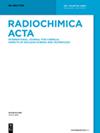Fabrication and characterization of graphene oxide and reduced graphene oxide decorated diatomite composite materials and their adsorption performance for uranium ions
IF 1.7
3区 化学
Q4 CHEMISTRY, INORGANIC & NUCLEAR
引用次数: 0
Abstract
In this study, the composite materials based on the incorporation of diatomite of graphene oxide (GO)/reduced graphene oxide (rGO/diatomite) were developed and characterized by different techniques (SEM, XRD, FTIR and BET). Developed composites were used for the first time in the removal of uranium ions from aqueous solutions. In adsorption studies, parameters affecting the adsorption efficiency such as solution pH, temperature, contact time and initial U(VI) concentration were investigated using full factorial experimental design (FFED). ANOVA (analysis of variance) analysis within the 95 % confidence interval of the model applied to control the compatibility of the model and the experimental findings was examined. Langmuir, Freundlich and Temkin isotherms were used to determine the adsorption model and related parameters were calculated. In addition, adsorption thermodynamic parameters such as enthalpy, Gibbs free energy change and entropy were calculated. The uranium removal behaviour on GO/diatomite and rGO/diatomite was better characterized by the pseudo-second order and Langmuir models, indicating that uranium ions were chemically adsorbed onto composite materials. Additionally, it was observed that higher temperatures promoted the uranium removal on GO/diatomite and rGO/diatomite, suggesting that the removal process was a spontaneous endothermic and exothermic reaction, respectively. In addition, the adsorption of U(VI) with GO/diatomite and rGO/diatomite was investigated using density functional theory (DFT) study. Configuration and adsorption energy were determined. The GO/diatomite composite materials can be a promising candidate as an adsorbent for the removal of uranium from aqueous solutions.氧化石墨烯和还原氧化石墨烯装饰硅藻土复合材料的制备与表征及其对铀离子的吸附性能
本研究开发了基于硅藻土的氧化石墨烯(GO)/还原氧化石墨烯(rGO/硅藻土)复合材料,并通过不同的技术(SEM、XRD、FTIR 和 BET)对其进行了表征。开发的复合材料首次用于去除水溶液中的铀离子。在吸附研究中,使用全因子实验设计(FFED)研究了影响吸附效率的参数,如溶液 pH 值、温度、接触时间和初始铀(VI)浓度。在模型的 95% 置信区间内进行方差分析,以控制模型与实验结果的兼容性。利用 Langmuir、Freundlich 和 Temkin 等温线确定了吸附模型,并计算了相关参数。此外,还计算了吸附热力学参数,如焓、吉布斯自由能变化和熵。假二阶模型和 Langmuir 模型较好地描述了 GO/diatomite 和 rGO/diatomite 上的铀去除行为,表明铀离子在复合材料上被化学吸附。此外,还观察到较高的温度促进了 GO/diatomite 和 rGO/diatomite 上铀的去除,这表明去除过程分别是自发的内热和放热反应。此外,还利用密度泛函理论(DFT)研究了 U(VI) 在 GO/diatomite 和 rGO/diatomite 上的吸附情况。确定了构型和吸附能。GO/硅藻土复合材料有望成为从水溶液中去除铀的吸附剂。
本文章由计算机程序翻译,如有差异,请以英文原文为准。
求助全文
约1分钟内获得全文
求助全文
来源期刊

Radiochimica Acta
化学-核科学技术
CiteScore
2.90
自引率
16.70%
发文量
78
审稿时长
6 months
期刊介绍:
Radiochimica Acta publishes manuscripts encompassing chemical aspects of nuclear science and technology.
 求助内容:
求助内容: 应助结果提醒方式:
应助结果提醒方式:


